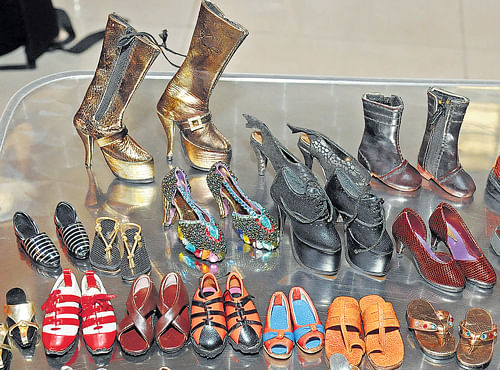
To have a hobby, one doesn’t really need to be of a certain caste, class or creed and KB Shivshankar, a cobbler on Davis Road, Cooke Town, proves that. It is very easy to miss his tiny green shop but when you reach the place, what grabs your attention is his collection of miniature shoes that’s very creatively displayed inside the place.
Ballet flats, slippers, kitten heels, stilettos, boots, sports shoes and clogs — all vie for attention in that small space. But it is only when you actually examine one that you realise what a perfect scaled-down model that the tiny shoe really is. It really makes one wonder what made this cobbler think of such a unique hobby. “I have always had a liking towards the art of shoemaking,” he explains.
Shivshankar is an old hand at making shoes. He took up the profession when he was eight after his father had passed away. “Being one of six children, I knew I had to start earning. I needed to ease the burden laid on my family. So I left school and started working. I worked in many different shops before starting my own stall,” he explains. The tiny shoes made their appearance about six years ago, while he was waiting for orders on regular shoes. Instead of sitting idle, he started making the shoes out of leftover materials.
When he started making miniature shoes, he earned a lot of praise from his customers. Some even offered to buy it from him for a small sum. But he was adamant not to sell these little creations. “This is not my bread and butter. It is something I do during my free time,” says Shivshankar, who hopes to enter the ‘Guinness Book of World Records’ with his collection someday.
He now has over 200 unique designs that he has created out of scrap leather and rubber from his shop. “Each pair takes more than an hour to make. That is, if I’m not interrupted with orders from customers midway,” he adds. And he admits that making these miniatures are far more challenging than the normal size shoes. “The biggest challenge is in making the mould out of wood. The smallest shoe is of one inch and the biggest is of five inches.
So, I have to first start by creating a mould for the shoe and then put the material together. Stitching the pieces together is another challenge as the stitches are very small and even one miss can cut your hand. I have actually cut my hand many times while doing this and making the heels,” he adds.
His collection has become so popular among the people living in that area that he has actually got orders to make a bigger shoe in the same designs.
“In a way these worked as good sample pieces. And looking at them gives me immense satisfaction,” he adds.
He also maintains them very well. Each pair is carefully packed in small plastic covers, which are then kept in a wooden box. “Now I have so many that I can’t keep all of them in my store, so I keep most of it at home,” he says.
There are no two pairs with the same design. Be it the colour or the decorative work on the shoe, each creation is well thought about in advance and planned. The inspiration for the designs comes from his family, he says.
“When I started this business, my only aim was that none of my children should go through what I went through or even end up like me. So I haven’t taught them my craft. Now I am happy that they are all well-settled. And it’s their happiness that inspires me to keep this hobby going. Someday, I hope this collection can enter the ‘Guinness Book of World Records’ and bring accolades to my State and country,” he says proudly.